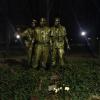Sign in to follow this
Followers
0

Article from Yorktown fire (10/3/11)
Started by
MoFire390,
-
Recently Browsing 0 members
No registered users viewing this page.

Started by
MoFire390,
No registered users viewing this page.